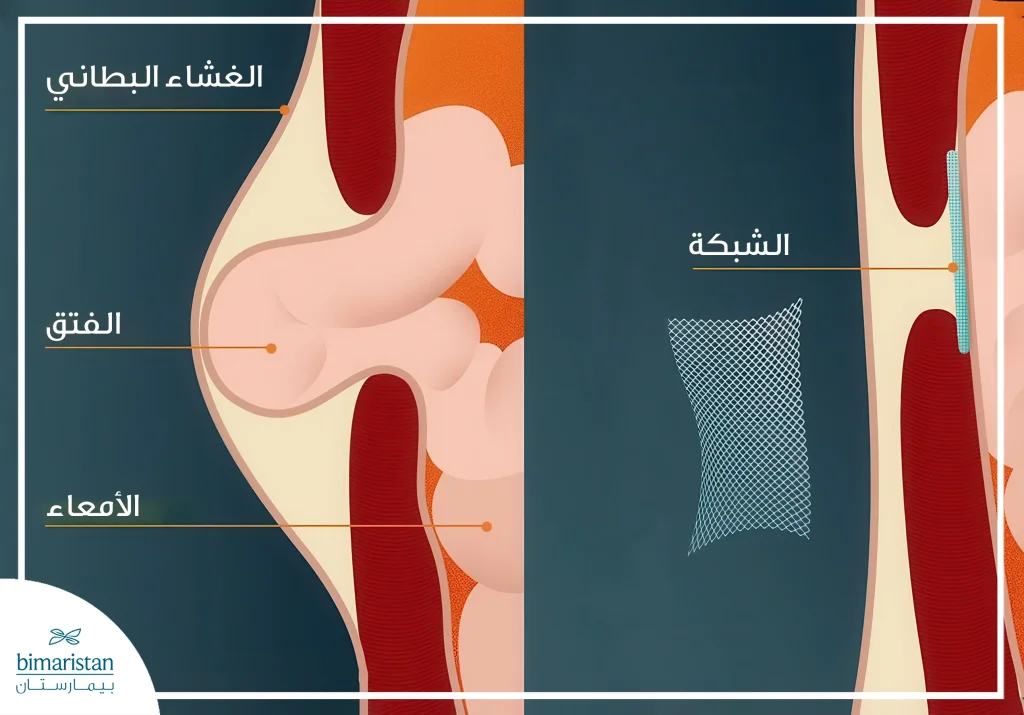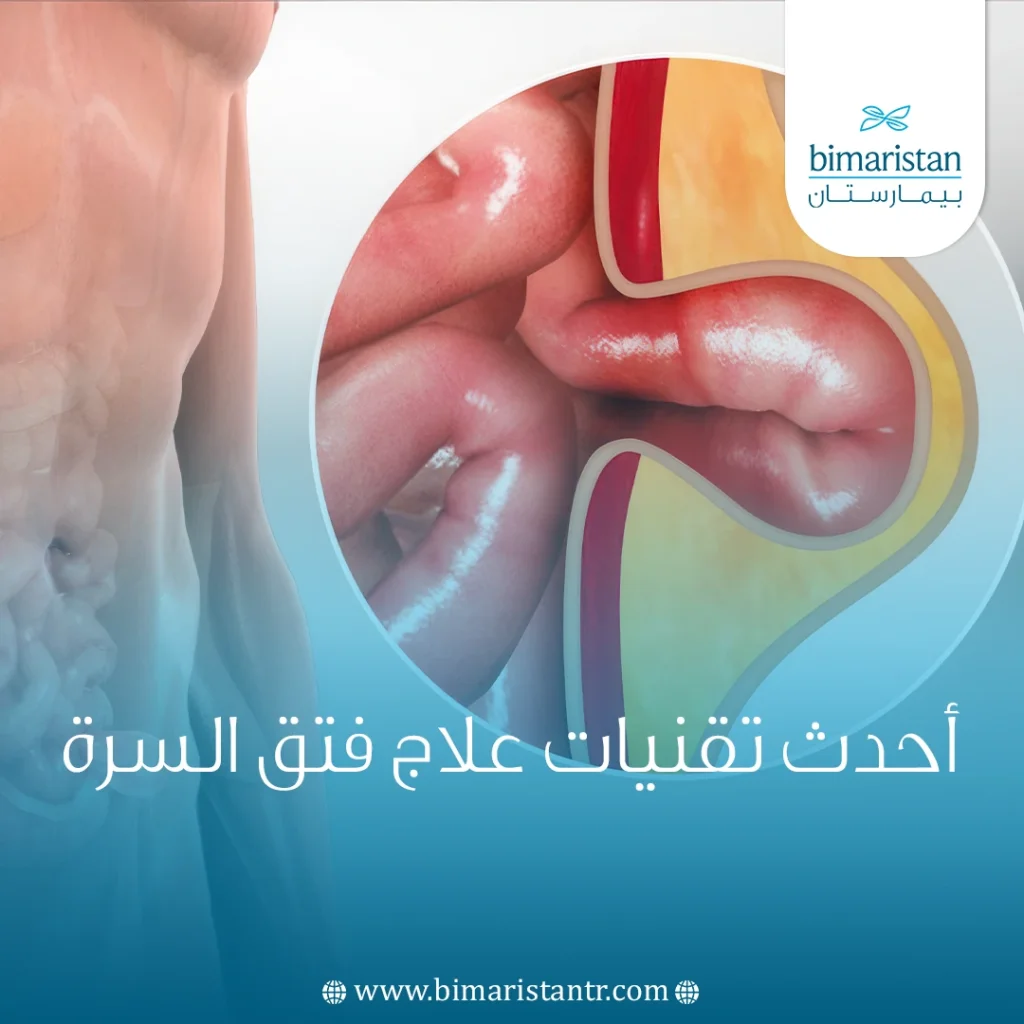إن فتق السرة هو حالة شائعة يمكن أن تؤثر على جودة الحياة، ولكن التقدم الطبي السريع قد أحدث تطورات كبيرة في طرق علاجه. لم يعد القلق من الجراحات المعقدة وأوقات التعافي الطويلة مبرراً، فبفضل أحدث تقنيات علاج فتق السرة أصبح الشفاء أسرع وأكثر فعالية وراحة. في هذه المقالة سنستعرض الأسباب والأعراض والمخاطر مع تسليط الضوء على هذه التقنيات المتطورة التي تضمن أفضل النتائج لمرضانا.
ما هو فتق السرة؟
فتق السرة (Umbilical hernia) هو حالة طبية تحدث عندما يبرز جزء من الأنسجة أو الأعضاء الداخلية من خلال نقطة ضعف في جدار البطن بالقرب من السرة. يمكن أن يحدث الفتق السري في أي مرحلة عمرية، من أهم الأسباب الشائعة للإصابة بفتق السرة:
- الولادة: قد يولد الأطفال مع فتق سري نتيجة عدم إغلاق الفتحة في جدار البطن بشكل كامل، وهو ما يجعل فتق السرة لدى الأطفال أمراً شائعاً
- السمنة: يزيد الوزن الزائد الضغط على جدار البطن مما قد يؤدي إلى حدوث الفتق.
- الحمل: تتعرض النساء الحوامل لتغيرات في ضغط البطن مما يزيد من خطر حدوث الفتق.
- رفع الأوزان: رفع الأثقال بشكل متكرر أو بشكل غير صحيح يمكن أن يؤدي إلى ضعف في جدار البطن.
أعراض فتق السرة
تشمل الأعراض الشائعة لفتق السرة:
- تورم أو نتوء في منطقة السرة: يظهر بشكل بارز عند السعال أو الضغط على البطن وقد يزداد حجم النتوء عند الوقوف أو القيام بأنشطة بدنية.
- ألم أو انزعاج: يمكن أن يشعر المريض بألم خفيف إلى متوسط في منطقة السرة وقد يزيد الألم عند القيام بحركات معينة مثل رفع الأشياء الثقيلة أو السعال.
- تغيرات في الحركة: قد يشعر المريض بصعوبة في القيام ببعض الأنشطة اليومية بسبب الألم أو الانزعاج.
- الغثيان أو القيء: في الحالات المتقدمة قد يحدث اختناق للفتق وقد يعاني المريض من الغثيان أو القيء.
متى يكون العلاج الجراحي ضرورياً؟
في بعض الحالات يجب على التدخل الطبي أن يكون سريعاً، من هذه الحالات:
- ألم شديد: إذا كان المريض يعاني من ألم شديد غير محتمل.
- اختناق الفتق: يحدث عندما يتم حبس الأنسجة في الفتق مما يمنع تدفق الدم إليها.
- عدم رجوع النتوء: إذا لم يتمكن المريض من دفع النتوء مرة أخرى إلى داخل البطن.
إذا كان الفتق غير مؤلم ولا يسبب أي مضاعفات يمكن للطبيب أن يوصي بمراقبة الحالة دون تدخل جراحي.
مخاطر إهمال علاج فتق السرة
إهمال علاج فتق السرة يمكن أن يؤدي إلى مجموعة من المضاعفات الصحية الخطيرة. إليك أبرز المخاطر المرتبطة بعدم العلاج:
- التهاب الأنسجة: إذا كانت الأنسجة محصورة لفترة طويلة قد تتعرض للعدوى. التهاب الأنسجة يمكن أن يؤدي إلى مضاعفات خطيرة تشمل تعفن الدم (sepsis).
- تمزق الفتق: قد يتمزق الفتق في بعض الحالات مما يؤدي إلى تسرب الأنسجة إلى تجويف البطن. التمزق يمكن أن يسبب ألماً شديداً ويؤدي إلى حالات طبية حرجة.
- تدهور الحالة الصحية العامة: الألم المستمر أو الانزعاج الناتج عن الفتق يمكن أن يؤثر سلباً على جودة حياة المريض.
- الحاجة إلى جراحة طارئة: إهمال علاج الفتق قد يتطلب تدخل جراحي عاجل في حالة حدوث مضاعفات. الجراحة الطارئة غالباً ما تكون أكثر تعقيداً وتحتاج إلى فترة تعافي أطول.
أحدث تقنيات علاج فتق السرة
تتضمن أحدث تقنيات علاج فتق السرة عدة خيارات متطورة، تشمل:
الجراحة بالمنظار (Laparoscopic hernia repair)
تعد من أحدث تقنيات علاج فتق السرة حيث يتم إدخال أدوات جراحية صغيرة وكاميرا عبر شقوق صغيرة في البطن، من ميزات هذه الطريقة:
- فترة استشفاء أقصر حيث يمكن للمرضى العودة إلى أنشطتهم اليومية بسرعة أكبر
- جرح صغير يقلل من الألم والندبات
- تقليل مضاعفات ما بعد الجراحة
استخدام الشبكات الطبية الحديثة (Hernia mesh)
تشمل هذه الطريقة استخدام الشبكات ذات الامتصاص الذاتي أو الشبكات ثلاثية الأبعاد وتعد من أحدث تقنيات علاج فتق السرة، من ميزات هذه الطريقة:
- توفر دعم إضافي لجدار البطن مما يقلل من خطر عودة الفتق
- تحسين النتائج الجمالية وتقليل الألم بعد العملية

الروبوت الجراحي (Robotic hernia surgery)
من أحدث تقنيات علاج فتق السرة، تستخدم هذه التقنية روبوتات جراحية متطورة لتسهيل العملية، من ميزات هذه الطريقة:
- دقة عالية في تنفيذ الجراحة مما يقلل من المخاطر
- نتائج أفضل على المدى الطويل بما في ذلك تقليل نسبة الانتكاس
مزايا تقنيات علاج فتق السرة بالمقارنة مع الإجرائات التقليدية
تتمتع أحدث تقنيات علاج فتق السرة بعدة مزايا مقارنة بالجراحة التقليدية، منها:
- تقليل مدة الإقامة في المستشفى: حيث يمكن للمرضى العودة إلى منازلهم في وقت أقصر مما يقلل من التكاليف.
- تقليل احتمال عودة الفتق: حيث توفر التقنيات الحديثة دعماً أفضل لجدار البطن.
- تحسين النتائج التجميلية وتقليل الألم: مما يسهم في تحسين تجربة المريض بعد العملية.
فترة النقاهة وما بعد العملية
تتراوح مدة التعافي بعد العملية بين عدة أيام إلى أسابيع بحسب نوع الإجراء الذي تم اللجوء إليه. يُنصح المرضى باتباع نصائح غذائية وحركية محددة، مثل:
- تجنب الأنشطة الشاقة مثل رفع الأثقال أو ممارسة الرياضات القاسية خلال فترة التعافي
- تناول الأطعمة الغنية بالبروتين مثل اللحوم الخالية من الدهون والبيض والبقوليات
- شرب كميات كافية من الماء للحفاظ على الترطيب
- البدء في المشي الخفيف لتعزيز الدورة الدموية
علامات التحذير التي تستوجب مراجعة الطبيب
- الألم الشديد: الذي لا يزول مع المسكنات.
- التورم المتزايد: أو تغير لون المنطقة المحيطة بالعملية.
- حمى: من الممكن أن تشير إلى وجود عدوى.
يمثل فتق السرة تحدياً صحياً يمكن التعامل معه بفعالية كبيرة بفضل التطورات الحديثة في المجال الطبي. إن فهم طبيعة هذه الحالة وأعراضها ومخاطر إهمالها أمر بالغ الأهمية لاتخاذ القرار الصحيح في الوقت المناسب. مع توفر أحدث تقنيات علاج فتق السرة أصبح الأمل في التعافي التام وتحسين جودة الحياة أقوى من أي وقت مضى. لا تتردد في استشارة طبيبك للحصول على التوجيه الأمثل والاستفادة من هذه التقنيات الواعدة.
المصادر:
- Mohammad, W. M., Zakaria, H., Amin, M., Naim, M. M., & Qassem, A. (2015). Laparoscopic versus open umbilical hernia repair with mesh. International Journal of Surgery Research and Practice, 2(4), 1-5
- Henriksen, N. A., Montgomery, A., Kaufmann, R., Berrevoet, F., East, B., Fischer, J., Hope, W., Klassen, D., Lorenz, R., Renard, Y., Garcia Urena, M. A., & Simons, M. P. (2020). Guidelines for treatment of umbilical and epigastric hernias from the European Hernia Society and Americas Hernia Society. British Journal of Surgery


